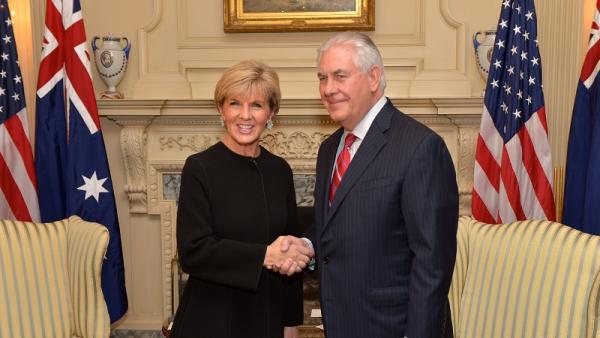Australia and the South China Sea: an update
/ Shutterstock

Elena Collinson, Senior Project and Research Officer, Australia-China Relations Institute, University of Technology Sydney |
Continuity, and no willingness to run American-style freedom of navigation
Australia’s position on the South China Sea remains pragmatic, unchanged over the last few years.
There is no evidence that hawkish calls for Australia to run American-style freedom of navigation operations (FONOPs) directed at China have influenced the policy of the Turnbull Government.
Those calls had been made by three US admirals on at least three separate occasions between the dates February 22 2016 and December 14 2016.
Vice Admiral Joseph Aucoin on February 22 2016 was asked whether ‘it would be valuable if Australia carried out [freedom of navigation] patrols within the 12 nautical mile limits around the created islands’. He replied, ‘Yes.’[1] On October 3 2016 retired Admiral Dennis Blair told the ABC’s Four Corners, ‘I think Australian and American ships should exercise together in the South China Sea, showing that, when they need to, they will send their armed forces international airspace and water.’[2] On December 14 2016 Admiral Harry B. Harris said in a speech in Sydney, ‘Should others signal in this way in freedom of navigation operations? I think so’.[3]
They were also made by Australian Strategic Policy Institute Director Peter Jennings, who said on November 16 2016: ‘I think the only sensible answer is we too, like the Americans, should be undertaking freedom of navigation operations in the South China Sea.’[4] On February 22 this year Mr Jennings reiterated his call for Australia to conduct US-style FONOPs stating, ‘[If] it’s my call I’d be saying we should do this from the point of view of promoting our own national interest.’[5]
Australia’s position adheres to the same oft-repeated formulation: Australia urges claimants to act in accordance with international law, to avoid coercive behaviour and unilateral actions, to engage in dialogue and to reach a resolution through peaceful means. Australia has also been consistent in asserting support for states’ rights under international law to freedom of navigation and freedom of overflight. Australia itself remains committed to regularly conducting maritime surveillance patrols of the South China Sea, as it has done for over 30 years as part of Operation Gateway, despite being routinely challenged by the Chinese Navy.[6]
Here we review the most recent statements by the Australian Government on the subject. They confirm Australia is not taking advice from either American admirals or local hardliners.
On December 14 2016 a US think tank, the Center for Strategic and International Studies (CSIS) released satellite images appearing to show installation of weapons systems on seven Chinese-constructed artificial islands in the Spratlys. Australian Foreign Minister Julie Bishop issued the following statement in response: ‘The building of artificial islands and the possible militarisation is creating an environment of tension and mistrust between claimants and other regional states. This is not in the interest of any state and will lead to reputation and other costs for claimants engaging in such behaviour.’[7]
The statement stopped short of directly naming China.
On February 23 2017 Reuters reported that China had ‘nearly finished building almost two dozen structures on artificial islands…that appear designed to house long-range surface-to-air missiles’.[8] The report seemed to be corroborated by the release of more CSIS satellite images showing at least eight nearly completed structures on Fiery Cross, Mischief Reef and Subi Reef.[9] There has been no public statement on the matter from Australia.
Following Australian Prime Minister Malcolm Turnbull’s first phone call with US President Donald Trump on January 28 2017 there was some speculation that the new US administration might seek quid pro quo from Australia for the honouring of the refugee deal. There was some conjecture that this could take the form of stepped-up involvement in the South China Sea.[10] On February 5 Mr Turnbull ruled this out on Channel Nine’s 60 Minutes: ‘We assess all requests for military assistance on their merits and there is no linkage, no linkage at all, between an arrangement relating to refugee resettlement and any other matters.’[11] This would appear to make it less likely an Australian government would be comfortable, in the wake of the deal on refugees, to change policy and commit to American-style patrols directed at China.
In fact, in a joint statement with New Zealand Prime Minister Bill English on February 17 2017, Prime Minister Turnbull reaffirmed that there was no change in Australian policy on the South China Sea. While the Prime Ministers ‘expressed their ongoing concern about the situation in the South China Sea’, they did not make explicit reference to China.[12]
Ms Bishop met her Chinese counterpart on February 7 2017 for the fourth Australia-China Foreign and Strategic Dialogue. In a press conference with Chinese Foreign Minister Wang Yi Ms Bishop welcomed progress in talks between claimant states and appeared to place Australia on the record endorsing the diplomatic course that China has argued for. She said, ‘We have in the past, and we continue to encourage all claims to build trust, to refrain from any provocative actions. In particular we have been welcoming of dialogue of recent times between the claimants, that does certainly reduce tensions and avoids any risk of miscalculation.’[13]
On February 23 2017 Ms Bishop met with US Secretary of State Rex Tillerson. The Australian Financial Review reported that during the meeting Ms Bishop firmly ruled out Australian FONOPs within the 12 nautical mile zone of Chinese-claimed features.
While the US has conducted FONOPs within the 12 nautical mile zone of contested features, Australia has never done so. Ms Bishop ‘told Mr Tillerson Australia will not change its past behaviour in the South China Sea and not escalate tensions with Beijing -- such as by deploying the navy to confront China near the islands.’ She reiterated, however, that ‘Australia will continue occasional routine freedom of navigation and overflight exercises around the broader South China Sea and insist on unimpeded trade.’[14]
Former Australian Defence Force Chief Angus Houston, in an address to the National Press Club on February 21 2017, also supported the view that Australia should concentrate on diplomacy and avoid conducting FONOPs within 12 nautical miles of China’s artificial islands. ‘I think that could provoke a response, a military response, and I don’t think that that would be a good idea...I think it’s all about diplomacy in the first instance,’ he said. Australian Defence Minister Marise Payne described Mr Houston’s comments as a ‘constructive contribution’.[15]
In the same speech Mr Houston touched on comments made by US Secretary of State Rex Tillerson during his confirmation hearing declaring China should be prevented from accessing its artificial islands. While Mr Tillerson has already walked this pronouncement back, Mr Houston observed, ‘I wouldn’t support [a blockade]. I think that that will invite a sharp response from the Chinese.’[16]
Ahead of his first state visit to Australia Indonesian President Joko Widodo told The Australian on February 23 that he would raise the possibility of joint Indonesia-Australia patrols in the South China Sea with Mr Turnbull. But while Mr Widodo said he saw joint patrols as ‘very important’, he stated that they should be conducted only when there is ‘no tension’ in the region.[17]
There was no reference to conducting joint patrols in either the joint statement issued by Australia and Indonesia or the Joint Declaration on Maritime Cooperation signed by the two leaders on February 26.[18]
On March 6, the prospect of Australia and Indonesia conducting joint patrols was ruled out by Ms Bishop. Speaking to press in Jakarta at the sidelines of the Indian Ocean Rim Association summit Ms Bishop said Mr Widodo was ‘talking about cooperating in maintaining freedom of overflight and freedom of navigation throughout the South China Sea’. Ms Bishop went on to say, ‘I don’t believe that [joint patrols] is what he was suggesting.’[19]
On the same day, following Ms Bishop’s comments, Indonesian Coordinating Minister for Maritime Affairs Luhut Pandjaitan told journalists, ‘I don’t know it is necessary for us to do joint patrols over there’.[20]
Endnotes
[1] Brendan Nicholson, ‘Send in the ships: US chief urges challenge to Beijing’, The Australian, February 23 2016 <http://www.theaustralian.com.au/national-affairs/defence/send-in-the-ships-us-chief-urges-challenge-to-beijing/news-story/8e71f880f3b1fd9e79ccf6e88db146cb>.
[2] Gavin Fernando, ‘Balancing act: Experts warn we can’t stay out of China’s conflicts’, news.com.au, October 4 2016 < http://www.news.com.au/finance/economy/world-economy/experts-warn-australia-cant-stay-out-of-chinas-conflicts/news-story/4cff9d168304576fbb2ca712053f2655>.
[3] AFP, ‘US warns ‘aggressive’ Beijing in South China Sea, Philippine Inquirer, December 15 2016 <http://globalnation.inquirer.net/150670/us-warns-aggressive-beijing-south-china-sea>.
[4] Sabra Lane, ‘Donald Trump likely to ask Australia to send ship to South China Sea: ex-Defence official Peter Jennings’, ABC News, November 17 2016 <http://www.abc.net.au/news/2016-11-17/donald-trump-likely-to-ask-australia-to-gol-to-south-china-sea/8035660>.
[5] Primrose Riordan, ‘Stay away from China, former defence chief warns’, The Australian, February 22 2017 <http://www.theaustralian.com.au/national-affairs/defence/stay-away-from-china-former-defence-chief-warns/news-story/9d9c584259e9c082d104b7e377b2b773>.
[6] Andrew Greene, ‘Australia to continue patrols across South China despite tensions: Air Force chief’, ABC AM, July 20 2016 <http://www.abc.net.au/am/content/2016/s4503772.htm>.
[7] David Wroe, ‘Julie Bishop accuses China of fuelling ‘tension and mistrust’ by weaponising artificial islands’, Sydney Morning Herald, December 15 2016 <http://www.smh.com.au/federal-politics/political-news/julie-bishop-accuses-china-of-fuelling-tension-and-mistrust-by-weaponising-artificial-islands-20161215-gtbruo.html>.
[8] Idrees Ali, ‘Exclusive: China finishing South China Sea buildings that could house missiles – U.S. officials’, Reuters, February 23 2017 <http://www.reuters.com/article/us-china-usa-southchinasea-exclusive-idUSKBN161029>.
[9] Thomas Gibbons-Neff, ‘New satellite images show reinforced Chinese surface-to-air missile sites near disputed islands’, Washington Post, February 23 2017 <https://www.washingtonpost.com/news/checkpoint/wp/2017/02/23/new-satellite-images-show-reinforced-chinese-surface-to-air-missile-sites-near-disputed-islands/?utm_term=.fd522a3f6f82>.
[10] See, for example, Michelle Grattan, ‘Grattan on Friday: Malcolm Turnbull should walk away from the refugee deal’, The Conversation, February 2 2017 <https://theconversation.com/grattan-on-friday-malcolm-turnbull-should-walk-away-from-the-refugee-deal-72377>; Claire Bickers, ‘Donald Trump ‘upset and angry’ over refugee deal discussed with Malcolm Turnbull’, news.com.au, February 3 2017 <http://www.news.com.au/finance/work/leaders/donald-trump-still-undecided-about-deal-made-with-malcolm-turnbull-to-take-in-refugees/news-story/fbdac6ae86d62ff0f03bd8d51637a47a>.
[11] David Crowe, ‘Malcolm Turnbull rules out US trade-off’, The Australian, February 6 2017 <http://www.theaustralian.com.au/national-affairs/foreign-affairs/malcolm-turnbull-rules-out-us-tradeoff/news-story/7e247189d6863455d717de0cd2f75913>.
[12] Joint statement by Prime Ministers the Rt Hon Bill English and the Hon Malcolm Turnbull MP, February 17 2017 <https://www.pm.gov.au/media/2017-02-17/joint-statement-prime-ministers-rt-hon-bill-english-and-hon-malcolm-turnbull-mp>.
[13] Julie Bishop, Australia-China Foreign and Strategic Dialogue – joint press conference with Chinese Foreign Minister Wang Yi, February 7 2017 <http://foreignminister.gov.au/transcripts/Pages/2017/jb_tr_170207.aspx?w=tb1CaGpkPX%2FlS0K%2Bg9ZKEg%3D%3D>.
[14] John Kehoe, ‘Julie Bishop lays out China policy to Trump team’, Australian Financial Review, February 23 2017 <http://www.afr.com/news/politics/julie-bishop-lays-out-china-policy-to-trump-team-20170223-gujfka>.
[15] Primrose Riordan, ‘Stay away from China, former defence chief warns’, The Australian, February 22 2017 <http://www.theaustralian.com.au/national-affairs/defence/stay-away-from-china-former-defence-chief-warns/news-story/9d9c584259e9c082d104b7e377b2b773>.
[16] Gareth Hutchens, ‘Australia should not join US in South China Sea operations, says retired defence chief’, The Guardian, February 21 2017 <https://www.theguardian.com/world/2017/feb/21/australia-should-not-join-us-in-south-china-sea-operations-says-retired-defence-chief>.
[17] Amanda Hodge, ‘Jokowi to raise joint patrols in South China Sea’, The Australian, February 23 2017 <http://www.theaustralian.com.au/national-affairs/foreign-affairs/jokowi-to-raise-joint-patrols-in-south-china-sea/news-story/9e7eb2c67704260bed03d582aa2d2deb>.
[18] Joint statement between the Government of Australia and the Government of the Republic of Indonesia, February 26 2017 <https://www.pm.gov.au/media/2017-02-26/joint-statement-between-government-australia-and-government-republic-indonesia>.
[19] Jewel Topsfield, ‘Julie Bishop denies Indonesian president suggested joint patrols in South China Sea’, Sydney Morning Herald, March 6 2017 <http://www.smh.com.au/world/julie-bishop-denies-indonesian-president-suggested-joint-patrols-in-south-china-sea-20170306-gurxlb.html>.
[20] Jewel Topsfield, ‘Julie Bishop denies Indonesian president suggested joint patrols in South China Sea’, Sydney Morning Herald, March 6 2017 <http://www.smh.com.au/world/julie-bishop-denies-indonesian-president-suggested-joint-patrols-in-south-china-sea-20170306-gurxlb.html>.
Author
Elena Collinson, Senior Project and Research Officer, Australia-China Relations Institute, University of Technology Sydney

